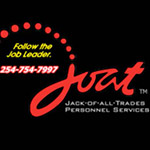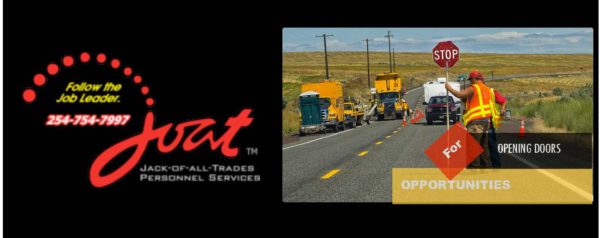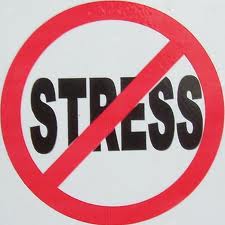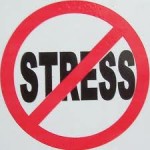
by cjxpadmin | May 1, 2016 | Employer Spotlight, Job Market, Job Readiness, Job Search

Jack Of All Trades Personnel Services – a dedication to the growth and productivity of our clients and  their people. It is very evident that a company is made by its people. Every business depends on its people for success.
their people. It is very evident that a company is made by its people. Every business depends on its people for success.
This makes hiring a crucial part of your company’s operations.
This is also where we come into the picture – Jack Of All Trades Personnel Services is at your service to support you in Human Resource Pooling, Job Matching and Employment. We screen our applicants and sort them according to experience and specialization. This makes it more efficient for us to provide you with the staff that you need when you need them.
We respond to your staffing needs promptly. Call our office to begin services – 254-754-7997.
Employee
Jack-of-All-Trades Personnel Services is a full-range employment agency representing the best companies in central Texas. We place qualified workers in short-term, long-term, temp-to-hire and permanent positions.
We invite you to check us out!
Jack-of-All-Trades is an “Equal Opportunity Employer”.
Jack Of All Trades has much to offer:
- Vacation Pay
- Safety Awards
- Medical, Dental, and Vision Insurance Available
- Telephone Answered 24/7 by a trained counselor
- Bilingual Counselors

by cjxpadmin | Mar 1, 2013 | Job Readiness, This Issue's FEATURE
By Sharon Rector
“Don’t ever feel that you are the only one to ever have done something silly or said something crazy. We all do it! Yours truly… especially!
I had not ever had any kind of experience in an office environment, when I accepted my first secretarial position. It was very new to me, and I was just a kid fresh out of business college trying to make it in the “real world.” During my first week on the job, I made many, many mistakes. I would fill my trash can every day with mistakes! One of the bosses noticed my trash can one day and told me that at the end of every day, they had someone go through everyone’s trash and make notes of all the mistakes they found there. He said they would deduct pay from your paycheck according to the number of mistakes that were found.
Naive as I was, I believed him! I carried my trash home for a week before I found out he was just ‘pulling my leg.’ Yoli”
Over the course of this year, we are going to concentrate on the varying aspects of the term “professional presence.” Get familiar with the essence of the term so that you are knowledgeable of what it is, how you attain it, and how you maintain it throughout your chosen career path. 
What does the term “professional presence” mean? According to the dictionary, professional presence refers to a dynamic blend of poise, self-confidence, self-control, and style that enables a person to command respect in any situation—especially on your new job.
Professional presence includes how you appear physically, how you dress for work, the tone of your voice, facial expressions, and even your handshake. It entails how you communicate with others and how you behave in the midst of problems and issues.
In the article “Developing a Professional Presence,” it is reiterated that once a professional presence is acquired, it will permit one to project a confidence that others can quickly perceive the first time you meet. And to project confidence, you must feel confidence.
The article also highlights that though one may present excellent credentials, a boss is more likely to choose (out of possible candidates) the one who has style as well as substance.
Let’s imagine that you have just been through a grueling panel interview conducted by individuals who really have no perception of  YOU — the real you; what you know and what you don’t know! How do you survive the interview? Once hired, how do you maintain your confidence and poise on the job? Let’s take a look at some strategies that may help you during this period.
YOU — the real you; what you know and what you don’t know! How do you survive the interview? Once hired, how do you maintain your confidence and poise on the job? Let’s take a look at some strategies that may help you during this period.
Strategy Number 1: (This is my personal favorite). Say that you have been hired. Hooray! Great job! Now how do you proceed? My advice is to tread lightly. Never get too personal too quickly with those who will be your fellow workers. Your inner-most aspects of your life, at this moment, are just that— personal! Your primary function on your new job is not to make friends, but to showcase to your employer the skills, knowledge, and talents you highlighted during your interview.
Your employer is operating a business, not a social club! According to Author Helen Wilkie in “How Do You Develop Professional Presence?” she clearly states that you do want to develop and cultivate a respectful relationship with your peers, those above you on the organizational level, those below you, or the clients. Show that you can get along with others by exuding the best of you! But never forget that people do spread gossip and untruths and unpleasant rumors about their colleagues. In your professional life, it is probably better to maintain your credibility by showing that you are trustworthy and your ability to rise above the fray.
Strategy Number 2: Realize and accept the fact that if you don’t know, you just don’t know! Always be upfront with your employer  about mistakes or your need to take time and research problems you have to tackle. By doing so, this will show your employer that you have initiative and pride in your work.
about mistakes or your need to take time and research problems you have to tackle. By doing so, this will show your employer that you have initiative and pride in your work.
Never proceed on a project attempting to muddle your way through your work. Although it is your responsibility to acknowledge your skills and talent, there is no shame in declaring you have hit a road block temporarily! Admit your mistake and maintain your confidence and composure establishing with your employer that you have worth and value to the organization and that you intend to prove it!
Strategy Number 3: Finally, whatever you do, stay disciplined! Maintain your confidence and competence as you are now in the process of “image building!” You are establishing for yourself and those who work around you your brand.
Image is a term that could be defined as establishing your qualities, competence, and attitude; everything that is inherent to you, but it is also the picture that people around you will remember.
Helen Wilkie in “How Do You Develop a Professional Prescience” believes that you need to cultivate a reputation for doing things well, getting your work done correctly and completely on time, and getting along well with others. It is that professional presence that will be the strongest force in helping you climb the ladder of success.
In closing, let me quote two statements on professional presence. The first is by David McNally and Karl Speaks.
“Developing a strong personal brand involves all the little ways in which you express your feelings about yourself and present to others.”
~ David McNally & Karl Speak
This last quote is taken from Susan Bixler and Nancy Nix-Rice, authors of “The New Professional Image.”
“Books are judged by their covers, houses are appraised by their curb appeal, and people are initially evaluated on how they choose to dress and behave. In a perfect world, this is not fair, moral, or just. What’s inside should count a great deal more. And eventually it usually does, but not right away…..”
Credits:
1) Wilkie, Helen, “How Do You Develop a Professional Presence?” How Do You Develop a Professional Presence. 28 Apr 2007. Ezinearticles. com 19 Feb. 2013
http://ezinarticles.com/? How-Do-You-Develop-a-Professional-Prescience?&ID=544373
2) Resource.mcc.neb.edu/hmrl/files/hmrl/Metro NHMRL Text/p52-99 pdf
- Total Person Insight. Susan Bixler and Nancy Nix-Rice, “The New Professional Image.” Taken from article “Developing a Professional Presence, resource.mcc.neb.edu/hmrl/files/hmrl/Metro NHMRL. pp 53 & 56.
Upcoming Article for Month of April: Professional Presence: “Dressing Smart and Dressing the Part” △

by cjxpadmin | Feb 27, 2013 | Job Readiness, This Issue's FEATURE
by Sheena Williams
“March winds and April showers bring forth May flowers.”
However, before we can get to the flowers, we need to get through the wind and the showers! Spring is in the air, but so are storm clouds, high winds, and tornadoes. So, to make sure that you and yours are safe this weather season we have listed some safety tips to get you to the May flowers despite the March winds and April showers.
Tornadoes
Most people will tell you that during a tornado, you are safest in an underground shelter or a reinforced room with no windows. But  what do you do in the event that you don’t have either of those options? You can:
what do you do in the event that you don’t have either of those options? You can:
In homes or smaller buildings, find the northeast corner of a basement. Or if that is not an option, go to the smallest, most-interior room on the lowest floor, such as a closet or bathroom. Cover yourself to protect your body from flying objects.
- In schools, hospitals, factories or shopping centers, go to the smallest, most-interior room or hallway on the lowest floor. Stay away from glass or areas with wide roofs such as auditoriums and warehouses. Crouch down and cover your head.
- In high-rise buildings, go to the smallest, most-interior room or hallway. Stay away from exterior walls and windows.
- If you are in a car or mobile home… abandon them immediately! Cars and mobile homes provide no protection from tornado winds. Leave them and go to a substantial structure or designated tornado shelter.

- It used to be that if you were caught out in the open, you were to find an overpass or bridge, but now it is said not to do that. They provide little shelter and have proved to be some pretty deadly options.
- If caught in the open, lie flat in a culvert, ditch or depression and cover your head.
Lightning
So, you’re safe in your own home watching the lightning show safely from your living room, hmm? Well, please keep in mind that at any given time, there are over 2,000 thunderstorms on the planet that produce 44 flashes of lightning. This means that if you see a thunderstorm, it behooves you to take cover. During a thunder storm, here are a few tips to remember:
- If you feel your hair standing on end, squat with your head between your knees. Do not lie flat!
- Avoid using the telephone or other electrical appliances. Let’s say you do bite the bullet, wave off the impending storm, and get on your PC anyway. You open yourself up to a lot of problems like power surges, and possibly being electrocuted. We can’t tell you not to do it, but we strongly suggest that if you have to get on to an electronic device, please use your cell phone, tablet, or lap top; that way, you can unplug the device away from the wall and continue to use it.

- Do not take a bath or shower or stand near plumbing. If you are boating or swimming, get out of the water and move to a safe shelter on land as quickly as possible. This sounds pretty self-explanatory, but there are a large number of people who will hop in the shower to get squeaky clean or decide to take their loved ones out for a swim when a storm hits. This is definitely not the smartest or safest choice as water attracts and is a conduit for electricity. Please be careful.
- Seek shelter in a sturdy building. A hard-top automobile can also offer protection. If you are in a
 wooded area, seek shelter under a thick growth of relatively small trees. However, avoid isolated trees or other tall objects, water, fences, convertible cars, tractors and motorcycles.
wooded area, seek shelter under a thick growth of relatively small trees. However, avoid isolated trees or other tall objects, water, fences, convertible cars, tractors and motorcycles.
Flash Floods
They can occur anywhere, along rivers or creeks, in low water crossings or in a dry stream bed. They can occur during any month and at any time during the day. In fact, flash floods often occur at night when it is difficult to find an escape route. Flash floods can be deceptive, and they develop really fast. Flood waters are likely deeper and moving faster than you think. Everyone, especially children, should stay away from flooded creeks, streams or drainage ditches. Swiftly flowing water can quickly sweep away even the strongest swimmers. You should also know to:
- Leave your vehicle immediately if it stalls in flood waters. Move to higher ground if you can do so safely. Avoid low water
 crossings and use alternate routes to avoid flood prone areas.
crossings and use alternate routes to avoid flood prone areas.
- Most cars and light trucks will begin to float in as little as 12 inches of water. Act quickly; rising waters can make vehicle doors difficult to open.
- Soggy banks can collapse, dumping you into flood waters. So make sure to stay on firm land and embankments.
Hurricanes
 There is a lot that goes into protecting yourself from a hurricane. There are many things to do in order to prepare, during and after. It has been advised that we give you the link to a hurricane safety site as opposed to listing to do’s here: http://hurricanesafety.org/
There is a lot that goes into protecting yourself from a hurricane. There are many things to do in order to prepare, during and after. It has been advised that we give you the link to a hurricane safety site as opposed to listing to do’s here: http://hurricanesafety.org/
Safety Sites
http://www.nws.noaa.gov/safety.php
http://www.weather.gov/safety
https://dps.mn.gov/divisions/hsem/weather-awareness-preparedness/Pages/default.aspx
http://www.weatherwizkids.com/
△

by cjxpadmin | Feb 27, 2013 | Job Readiness, This Issue's FEATURE
Excerpt from Life Transitions, Managing Change
Creating Your Future
It has been said the path to your greatest personal growth is through your problems. You are invited to embrace your problems for  unless you have them, they will have you. There’s a huge difference between the two. You will always have problems. Life is a puzzle. The difference between someone who suffers from their problems and someone who learns and grows from them is in how you take them on. Your future will depend entirely on how you deal with your problems.
unless you have them, they will have you. There’s a huge difference between the two. You will always have problems. Life is a puzzle. The difference between someone who suffers from their problems and someone who learns and grows from them is in how you take them on. Your future will depend entirely on how you deal with your problems.
Taking a New Approach — From Reaction to Creation
 It is normal, understandable, and human to react negatively to the difficult times you might face. However, you want to be very clear that the stress and suffering you have is a result of how you choose to react. It is also possible to take on your problems with a minimum stress. If you choose to create rather than react, perhaps, there will be no suffering at all. It will be helpful if you can envision the whole chain of reactions, which shape your usual reaction to things. The goal is to turn reaction into creation. But first, look at the flow as it usually occurs.
It is normal, understandable, and human to react negatively to the difficult times you might face. However, you want to be very clear that the stress and suffering you have is a result of how you choose to react. It is also possible to take on your problems with a minimum stress. If you choose to create rather than react, perhaps, there will be no suffering at all. It will be helpful if you can envision the whole chain of reactions, which shape your usual reaction to things. The goal is to turn reaction into creation. But first, look at the flow as it usually occurs.
Circumstances
For most people, circumstances determine how they feel and operate in life. If things are pretty good, they feel good. If something  breaks down, they get upset. If you live this way, your experience of life must be like a roller coaster because things go from good to bad and bad to good on a regular basis. For most people, there are always enough circumstances to make life tough, if not downright stressful. You have taken the first step in shaping how you react to circumstances by choosing how you view your own circumstances. This is the first step in shifting out of reaction. Let’s look at a flow chart and see how important this step really can be.
breaks down, they get upset. If you live this way, your experience of life must be like a roller coaster because things go from good to bad and bad to good on a regular basis. For most people, there are always enough circumstances to make life tough, if not downright stressful. You have taken the first step in shaping how you react to circumstances by choosing how you view your own circumstances. This is the first step in shifting out of reaction. Let’s look at a flow chart and see how important this step really can be.
The Flow Chart – Reaction
(Start from the bottom to see the reaction sequence.)
Outcomes and Results
(Eventually our future will come from the actions we take or don’t take regarding the circumstances we are dealing with.)
Behaviors
(Actions we undertake, things we do or don’t do about circumstances, all stem from what we feel. Our emotions are our motivators. Being angry, sad, or depressed are not always great motivators.)
Emotions
(Attitude and thoughts bring up feelings. Emotions hold the energy for what we feel and what we will do. If we react negatively to our circumstances, then, stress eats at us. Every time we run the upsetting thoughts through our head, we feel those same upsetting emotions.)
Attitude
(Attitude is a gathering of thoughts, conversations, and agreements. What I think is right and true becomes the way I think about the situation. If my reaction is negative, then, my initial attitude will be negative also.)
Interpretation
(We have an immediate reaction: Is this going to be good or bad for me? The interpretation that circumstances are bad causes a negative reaction.)
Circumstances
(Things that matter enough to cause us to react such as no job, financial problems, kid(s) in trouble, or transportation issues.)
Learning A Better Way
You can see from the flow chart that our response to stressful circumstances is usually determined by the reactions we have to them. This begins with our basic interpretation of events, whether we like them or not, and it goes from there. What if, instead of reacting to circumstances, we create our response from a different place?
Let’s use the future we would like for ourselves as a place to come from in determining how we take on tough parts of our lives. This is a much wiser option. We all want a future that works for us where we are successful and happy. The question is what does it take to make that happen?
Drawn Forward By the Future
While your future is unknown and uncertain, you have the power to steer your life into a future worth having. Everyone wants a future  where you can love your life. The most important question for you to ask is, “Who do I have to be to make the future I want?” To have a successful future, you will have to act in ways that can make it happen. This is the principal behind shifting reaction to creation.
where you can love your life. The most important question for you to ask is, “Who do I have to be to make the future I want?” To have a successful future, you will have to act in ways that can make it happen. This is the principal behind shifting reaction to creation.
Let’s take another look at the flow chart and see how the future you want can determine the ways you respond to difficulties you face. This time, instead of starting at the bottom, start at the top with the outcomes you want and observe how that determines how you will act, feel, and the attitude necessary to put your mind to work for you.
The Flow Chart
(Start at the top with the outcomes you want.)
Outcomes and Results
(Create an idea or a vision for the future you want. From your vision, create goals that will help you understand what you must do to make a better future.)
Behaviors
(The actions you now take are aimed at making your desired goals happen. Behaviors and actions consistent with your goals is the surest way to have positive movement in your life.
Emotions
(Next, you must create emotions and feelings that naturally motivate you toward reaching your goals.)
Attitude
(The way to create a good attitude is by encouraging yourself to feel positive, confident, and determined. These new thoughts will keep you striving toward the life you want.)
Interpretation
(Armed with a new attitude, you are free to re-interpret your circumstances. Instead of seeing the circumstances as either good or bad, you may see the problems you face as perfect.)
Circumstances
(Things that matter enough to cause us to react, such as no job, financial problems, kid(s) in trouble, or transportation issues. Now you can have an effective and powerful response to these situations instead of just suffering. Putting your personal power to work for you is the most useful response to stress.)
While you have many choices to the path to your future, the path you select is YOURS. You choose if you want to be happy; happiness is a choice you make. Your career and friends are other choices you must make. So, as you decide what you want out of your future, you must take responsibility for that future. Attitude, interpretation, behavior and emotions all will determine the outcome of your future. A smile can affect your attitude, which controls your emotion, which then, drives your outcome. So, if nothing else start with a smile and a positive attitude, it may do wonders for you. △

by cjxpadmin | Dec 31, 2012 | January 2013 Magazine, Job Readiness
by FORBESWOMAN
Top Five Personality Traits Employers Hire Most
I know you: You’ve made looking for your next job, well… your job. You’ve scoured your resume of clichéd buzzwords, brushed up on body language and even gotten a handle on the dreaded video interview.
But all of that might be for naught if you just don’t have the personality sought by your dream employer. New research shows that the vast majority of employers (88%) are looking for a “cultural fit” over skills in their next hire as more and more companies focus on attrition rates. Lucky for you, we’ve drilled down into data from 1,200 of the world’s leading employers (think General Electric, P&G and Accenture) to find precisely the personalities big business seek.
Universum, the Stockholm-based employer branding firm that annually surveys over 400,000 students and professionals worldwide on jobs-related issues, has culled their data to the top five personality traits employers are looking for in job candidates in 2012. How’s that for a leg up on the competition?
“We surveyed employers to get a handle on the challenges that face them in hiring,” says Joao Araujo of Universum. “What are they looking for in employees and what are they not finding?” By identifying both traits, he says, aspiring job applicants can both identify the most sought after traits—and brush up resumes and interview tactics to best position themselves.
Professionalism (86%), high-energy (78%) and confidence (61%) are the top three traits employers say they are looking for in new hires. Kathy Harris, Managing Director of Manhattan-based executive search firm Harris Allied says these first-impression traits are the most critical for employers to prepare for as they all can be evaluated by a recruiter or hiring manager within the first 30 seconds of meeting a candidate.
“A manager can read you the moment you walk in the door,” she says; from the clothes you wear to the way you stand to the grip of your first hand-shake. Presenting yourself as a confident, energetic professional is about as basic as career advice gets. But don’t be off-put by this commonplace advice. Harris, who specialized in high-level executive placement says even the most seasoned of CEOs can get tripped up by the basics. Universum clients agree: confidence ranks highest on the list of skills companies think employees are missing most.
“We remind every candidate of the most granular advice,” she says. The most successful applicant is the one who walks into every interview with her hand outstretched for a handshake, has done her homework on the interviewer and company and is dressed to fit effortlessly into the culture of the workplace.
The remaining personality traits that Universum clients say are critical in the hiring process aren’t ones that can be read on-sight but instead call for both resume and interview preparation. To present yourself as a self-monitoring (58%) personality type, Harris says to adjust resume language to call attention to work experience where you’ve worked independently or excelled without the guidance of direct leadership. “In interviews, choose anecdotes that show how you’ve saved, made or achieved in previous positions… and how self-motivation was critical to that success.”
Intellectual curiosity (57%) is, fittingly, a curious trait for Harris, who says she generally advises clients to tightly edit the “hobbies and interests” sections of their resumes. “I’d imagine that in looking for intellectual curiosity, employers are looking for two things,” she says. “The ability to problem solve and the ongoing dedication to learning new technologies or solutions that will continue to advance in the changing workplace.” Employers are asking themselves whether new hires will be with the company for the long term, she says. An employee who will grudgingly adopt a new database is not as attractive as one who is truly passionate about learning new things. Δ
by cjxpadmin | Dec 31, 2012 | January 2013 Magazine, Job Readiness
by Forbes.com
10 Body Language Interview Mistakes
From eye contact to posture to the way you fix your hair, avoid these 10 physical slip-ups in your next job interview.
1. Bad Postured Posture
Leaning back is lazy or arrogant, leaning forward is aggressive and slouching is just lazy. Instead, experts say to aim for a neutral position, sitting tall as if a string were connecting your head to the ceiling.
2. Breaking Eye Contact
“Hold eye contact one extra eyelash,” says Charisma Coach Cynthia Burnham. She says we tend to feel uncomfortable holding eye contact once a personal connection has been created. Don’t stare, but try to hold your interviewer’s gaze for one extra second before breaking away. “Do this especially when shaking hands,” she says.
3. Chopping and Pointing
Cynthia Burnham, a California-based Charisma Coach, says chopping or pointing motions can “cut up” the space between you and your interviewer in an aggressive way.
4. Crossed Arms
“Arms crossed over your chest signals defensiveness and resistance,” says Karen Friedman, Communications Expert. “When they’re open at your sides, you appear more approachable.”
5. Excessive Nodding
“Sometimes we undermine how powerful or in focus we are by nodding like a bobble-head doll,” says Burnham, a habit that’s particularly common in women. “Nod once or twice with a smile of agreement. But find your still center and stay there.”
6. Fidgeting
“Stop fidgeting!” says Amanda Augustine of TheLadders. “The nervous energy will distract the interviewer. You want [him or her] focused on what you have to say, not the coins jingling in your pocket or the hangnail on your finger.”
7. Hands Behind Back
It’s important to appear approachable and open, so don’t try to control gestures or fidgeting by keeping your hands still. This is especially important when you begin to speak, says Friedman. “Keeping your hands in your pockets or behind your back inhibits movement and makes you appear stiff.”
8. Mismatched Expressions
“If your tone isn’t matching your facial expression, you could find yourself in hot water,” says Communications Coach Matt Eventoff. “If someone asks what you’re most passionate about and your face is in deadpan while you answer, it’s not going to translate well.”
9. Shifty Eyes
Friedman says distracted or upward eye movements can suggest someone is lying or not sure of themselves. “It’s important to look someone directly int he eye to convey confidence and certainty.”
10. Staring
“It’s important to be confident and look the interviewer in the eye,” says Amanda Augustine, Job Search Expert at TheLadders. “But then break away. Locking eyes with someone for an extended period of time can be interpreted as aggressive, not to mention creepy. Δ


 their people. It is very evident that a company is made by its people. Every business depends on its people for success.
their people. It is very evident that a company is made by its people. Every business depends on its people for success.
















